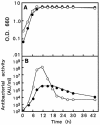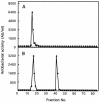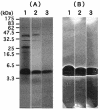Purification and characterization of a novel bacteriocin produced by Enterococcus faecalis strain RJ-11
- PMID: 14532021
- PMCID: PMC201181
- DOI: 10.1128/AEM.69.10.5546-5553.2003
Purification and characterization of a novel bacteriocin produced by Enterococcus faecalis strain RJ-11
Abstract
Lactic acid bacteria exhibiting activity against the gram-positive bacterium Bacillus subtilis were isolated from rice bran. One of the isolates, identified as Enterococcus faecalis RJ-11, exhibited a wide spectrum of growth inhibition with various gram-positive bacteria. A bacteriocin purified from culture fluid, designated enterocin RJ-11, was heat stable and was not sensitive to acid and alkaline conditions, but it was sensitive to several proteolytic enzymes. Sodium dodecyl sulfate-polyacrylamide gel electrophoresis analysis revealed that enterocin RJ-11 had a molecular weight of 5,000 in its monomeric form. The amino acid sequence determined for purified enterocin RJ-11 exhibited high levels of similarity to the sequences of enterocins produced by Enterococcus faecium.
Figures





Similar articles
-
Isolation and characterization of enterocin EJ97, a bacteriocin produced by Enterococcus faecalis EJ97.Arch Microbiol. 1998 Dec;171(1):59-65. doi: 10.1007/s002030050678. Arch Microbiol. 1998. PMID: 9871020
-
Isolation and characterization of enterocin SE-K4 produced by thermophilic enterococci, Enterococcus faecalis K-4.Biosci Biotechnol Biochem. 2001 Feb;65(2):247-53. doi: 10.1271/bbb.65.247. Biosci Biotechnol Biochem. 2001. PMID: 11302155
-
Preliminary characterization of bacteriocins produced by Enterococcus faecium and Enterococcus faecalis isolated from pig faeces.J Appl Microbiol. 2000 Mar;88(3):482-94. doi: 10.1046/j.1365-2672.2000.00986.x. J Appl Microbiol. 2000. PMID: 10747229
-
AS-48 bacteriocin: close to perfection.Cell Mol Life Sci. 2011 Sep;68(17):2845-57. doi: 10.1007/s00018-011-0724-4. Epub 2011 May 17. Cell Mol Life Sci. 2011. PMID: 21590312 Free PMC article. Review.
-
Two-component signal transduction in Enterococcus faecalis.J Bacteriol. 2002 Nov;184(21):5819-25. doi: 10.1128/JB.184.21.5819-5825.2002. J Bacteriol. 2002. PMID: 12374813 Free PMC article. Review. No abstract available.
Cited by
-
Mutacins from Streptococcus mutans UA159 are active against multiple streptococcal species.Appl Environ Microbiol. 2011 Apr;77(7):2428-34. doi: 10.1128/AEM.02320-10. Epub 2011 Feb 4. Appl Environ Microbiol. 2011. PMID: 21296932 Free PMC article.
-
Purification and characterization of enterocin 62-6, a two-peptide bacteriocin produced by a vaginal strain of Enterococcus faecium: Potential significance in bacterial vaginosis.Microb Ecol Health Dis. 2007 Jul 30;19(4):241-250. doi: 10.1080/08910600701538240. Microb Ecol Health Dis. 2007. PMID: 19578555 Free PMC article.
-
A Novel High-Molecular-Mass Bacteriocin Produced by Enterococcus faecium: Biochemical Features and Mode of Action.Probiotics Antimicrob Proteins. 2018 Sep;10(3):427-434. doi: 10.1007/s12602-018-9392-0. Probiotics Antimicrob Proteins. 2018. PMID: 29423898
-
Production and characterization of a new antibacterial peptide obtained from Aeribacillus pallidus SAT4.Biotechnol Rep (Amst). 2015 Sep 21;8:72-80. doi: 10.1016/j.btre.2015.09.003. eCollection 2015 Dec. Biotechnol Rep (Amst). 2015. PMID: 28352575 Free PMC article.
-
Bacteriocin diversity in Streptococcus and Enterococcus.J Bacteriol. 2007 Feb;189(4):1189-98. doi: 10.1128/JB.01254-06. Epub 2006 Nov 10. J Bacteriol. 2007. PMID: 17098898 Free PMC article. Review. No abstract available.
References
-
- Arai, Y., M. Uehara, Y. Sato, M. Kimira, A. Eboshida, H. Adlercreutz, and S. Watanabe. 2000. Comparison of isoflavones among dietary intake, plasma concentration and urinary excretion for accurate estimation of phytoestrogen intake. J. Epidemiol. 10:127-135. - PubMed
-
- Arliss, R. M., and C. A. Biermann. 2002. Do soy isoflavones lower cholesterol, inhibit atherosclerosis, and play a role in cancer prevention? Holist. Nurs. Pract. 16:40-48. - PubMed
-
- Chuyen, N. V., K. Ijichi, H. Umetsu, and K. Moteki. 1998. Antioxidative properties of products from amino acids or peptides in the reaction with glucose. Adv. Exp. Med. Biol. 434:201-212. - PubMed
MeSH terms
Substances
Associated data
- Actions
LinkOut - more resources
Full Text Sources
Other Literature Sources
Molecular Biology Databases

